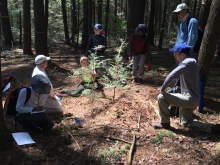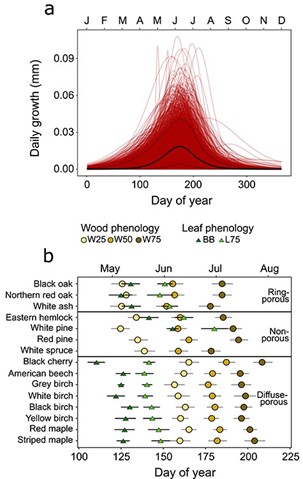You are here
Study Tracks Seasonal Growth and Water Shortage in Trees

By Anna Christensen
A paper published this past summer in Tree Physiology finds that tree species of varying wood-porosity experience peak growth at different times of the year, exposing some species to more intense water shortages than others.
The wood-porosity of a tree refers to the structure of its vessels—pipelines within the trunk that carry sap throughout the tree.
Some trees such as red maple, paper birch, and American beech, have diffuse-porous structures. This means that they develop vessels that are similar in size throughout the growing season.
Other trees, like the white ash and northern red oak, have ring-porous structures, meaning they develop large vessels early in the growing season and smaller ones as the season goes on. Coniferous trees don’t have vessels, so are considered non-porous.
Loïc D’Orangeville and colleagues found that for tree species with diffuse-porous wood structures, peak growth occurs almost a month later than for trees with ring-porous or conifer structures. This growth occurs at a time of lower water availability and higher temperatures, exposing these trees to greater water shortages during their most important growth period.

This work is revealing the importance of vessel structure to long-term histories of tree species. As Loïc explains, “Late-summer droughts and winter freeze-thaw events can damage the conducting vessels of trees. The large vessels developed in spring by ring-porous trees allow them to restore their water conductive capacity, giving them an edge over other trees. This could explain why the number of ring-porous species increased rapidly since the Cretaceous, when the climate was much warmer than today.”
Harvard Forest Senior Ecologist, Neil Pederson, a co-author on the paper, reflects: “The work led by Loïc was really eye opening to me. First, even though forest ecology is more than 100 years old in the eastern US, let alone the Harvard Forest, this work revealed that we did not have a firm grasp on when the stems of rather common tree species grew during the summer.”
The researchers used data collected over the course of six years (1998-2003) when dendrometer bands were used to measure the growth of more than 800 trees across multiple plots in the Harvard Forest. They then examined seasonal patterns of growth as they related to wood-porosity.
As climate modelling predicts warmer summers and more frequent and severe droughts in US East-coast forests, this study shows how wood-porosity may help predict seasonal climate sensitivity in different tree species. Neil adds, “These small changes have the potential to impact the interactions of multiple species in our forests.”
Figure: Wood and leaf phenology over 1999–2003 across individuals (red curves) and averaged per species (colored symbols).
Photo: HF scientists and students work together to core hemlock saplings. Photo by Neil Pederson.

